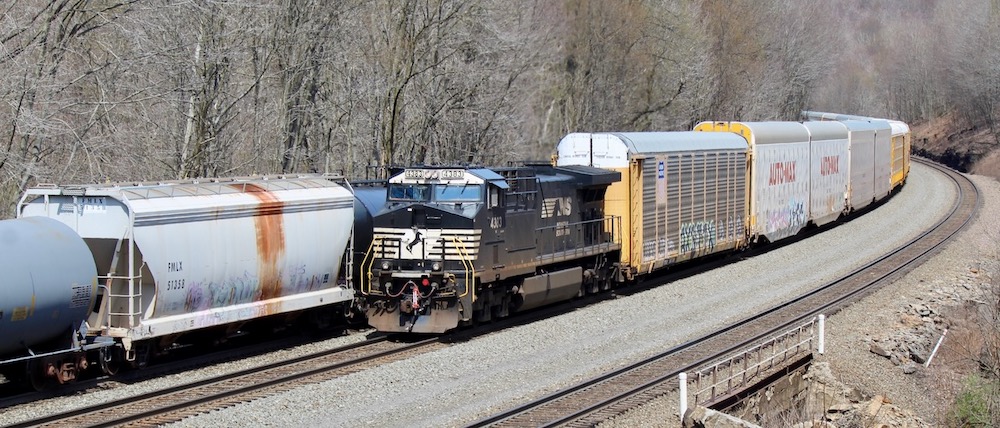UAW strike

A potential United Auto Workers strike against the Big Three automakers would put a dent in railroads’ motor vehicle and parts volume – the traffic segment that’s shown the most growth this year as overall rail volume has declined.
The UAW has set a midnight deadline tonight for a strike at Ford, GM, and Stellantis, with the union and automakers far apart on wages, pensions, cost of living adjustments, and profit sharing. Yesterday UAW President Shawn Fain said the union would strike at selected plants first, followed by others if talks with the automakers don’t make progress.
So far this year motor vehicles and parts have accounted for 3.2% of U.S. rail traffic, according to Association of American Railroads data. The segment is up 13.4% so far this year, while overall U.S. traffic has slumped 4.8%, according to the AAR.
Norfolk Southern directly serves just over half of all light vehicle production in the U.S., with the Big Three accounting for 30% to 40% of the railroad’s automotive volume, CEO Alan Shaw said at the FTR Transportation Intelligence conference yesterday.
“There are finished vehicles waiting to be moved. So we could see normal volumes on us for a week to 10 days before it has any impact,” Shaw says of a potential strike.
Auto sales have rebounded this year from the computer chip shortage that began during the pandemic and crimped production. Last month S&P Global Mobility projected that auto sales this year would be 15.4 million units – its highest level since 2019 and an 11.6% increase from 2022.
Last year the Big Three accounted for 43% of U.S. auto sales.














When the UAW and the big 3 finally sign a contract, 40 percent wage increase and 32 hour work week will not be included. And both side know it. Remember, vehicles assembled by the big 3 and other companies in Mexico, and vehicles built by Toyota, Honda etc in the US sell for the same price as union built vehicles. So UAW isn’t the only problem, corporate greed also enters into the equation.
CPKC is well-positioned to gain long-term from the strike. It’s no secret that Stellantis already wanted to close half of its U.S. and Canadian facilities. And, much of their Ram pickup production us already in Mexico. The strike could be just the push they need to close-up U.S. and Canadian production and move things to Mexico and elsewhere. More production in Mexico will mean more auto volume for CPKC.
As I type this the strike has begun. The UAW planned to strike critical component plants at all three US Domestic Automakers, rather than a General Strike against all plants. This would curtail production without causing all members to be technically on strike. This will likely cause the companies to Lock-out the remaining workers.
I think the strategy is to cripple all three corporations while putting most of thecost burden on Unemployment Insurance rather than the UAW strike fund. Anyway I haven’t yet dialed up the two on-line newspapers, Detroit News or The Freep, to see what happens with today’s shifts.
I saw a review of what the union is demanding. This could be a long strike as I don’t see how the companies can give in to everything. They would lose significant market share due to having to raise their prices beyond what it is safe to hold on to their clients.
How many of the assembly plants in the US don’t assemble cars of the “Big Three”? Does Honda still have the Marysville, OH plant? How many other non big three assembly plants are there in the US now.
PAUL — The answer is, a whole lot of transplant plants, from, Indiana and Ohio to Kentucky, Tennessee, Texas. Alabama, South Carolina and Mississippi.
Thing is, Paul, these plants now longer produce little Japanese compact cars. They make profitable pickup trucks, and huge SUVs, and the people haulers F/K/A “minivans” which are now the size of a school bus.
Even Nissan is Smyrna (Tennessee) is still operating, the oldest of the transplants Given the plant’s age and the checkered reputation of its brand, it was said to be on the bubble. It’s still there. Which is more than can be said for Stellantis at Belvidere, Illinois.
In other words, well over half of the railroads’ auto volume would be unaffected. My, how the “Big Three” have fallen.
Like everything else, automotive has changed. I don’t know what’s left of the billboard-like hi-cube boxcar fleet that hauled auto parts in decades past. Chessie, N&W, Conrail and especially GTW owned these. From what I saw, Ford and GM were the big customers, Chrysler hauling stuff in its own semis over the highways. These were the days before auto parts came in forty-foot steamship boxes from China or Korea, bound for auto plants not in Michigan and not owned by the former “Big Three”.